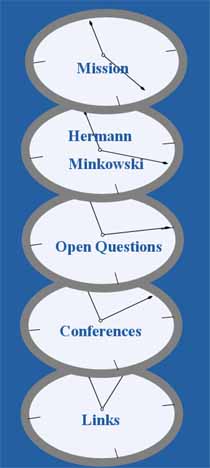 |
|
|
|
 |

|
|
Condensed Matter Physics and the Nature of Spacetime
Jonathan Bain
Open Question: To what extent can spacetime be modeled as a quantum liquid? Why would anyone want to do this, and what are the implications of doing so?
Background: In the philosophy of spacetime literature not much attention has been given to concepts of spacetime arising from condensed matter physics. These are based on analogies between spacetime and a quantum liquid that have arisen from effective field theoretical approaches to highly correlated many-body quantum systems. Such approaches have suggested to some authors that spacetime can be modeled by a quantum liquid with its contents (matter and force fields) being given by effective field theories (EFT's, hereafter) that describe the low-energy excitations of this liquid. While directly relevant to ongoing discussions concerning the ontological status of spacetime, this programme also has many consequences that philosophers of physics in general should be interested in. It suggests, for instance, a particular approach to quantum gravity (e.g., Smolin 2003), as well as an "anti-Grand Unified Theory", anti-reductionalist attitude towards the nature of symmetries and EFT's in quantum field theory (e.g., Zhang 2004, Volovik 2003, Laughlin and Pines 2000, Froggatt and Nielsen 1991). While some discussion of these topics has appeared in the philosophical and historical literature (e.g., Cat 1999), the gory theoretical details have not been made explicit. Moreover, while the topic of EFT's in the philosophy of quantum field theory literature has also been given some attention (e.g., Castellini 2002, Hartmann 2001, Huggett and Weingard 1997, Cao and Schweber 1993), surprisingly little has been said about how EFT's arise in condensed matter systems. Examples of simple (2+1)-dimensional EFT's in condensed matter systems include (see, e.g., Zhang 2004):
- (2+1)-dim quantum electrodynamics in superfluid Helium 4 films and in high temperature superconductors
- (2+1)-dim Chern-Simons gauge theory of the 2-dim Quantum Hall Effect
One extraordinary property of these EFT's is the emergence of a Lorentz-invariant theory in the low-energy sector of a non-relativistic theory (in the case of the 2-dim Quantum Hall Effect, the relativistic theory emerges at the edges of the system). The extent to which such theories carry over to (3+1)-dimensions should be of interest to philosophers of spacetime. Examples indicating this extent include:
- Superfluid Helium 3 as a condensed matter analog of the standard model. Various authors have pointed out similarities between the symmetries of the stable phases of 3He and those of the standard model (e.g., Volovik 2003, Vollhardt and Wölfle 2000)). These similarities are consequences of describing the phases as EFT's of low-energy excitations of the superfluid. It then transpires that the topological properties of the associated vaccua are identical to those of vaccua that appear in the Standard Model.
- Superfluid Helium 4 as a condensed matter analog of general relativity. Volovik (2003) suggests such an analogy sheds light on the cosmological constant problem, and a variety of authors suggest such an analogy sheds light on black hole physics via "acoustic" black holes (Laughlin 2003, Novello et al. 2002, Visser 1998, Unruh 1981)
- 4-dimensional Quantum Hall Effect liquids and twistor theory. Sparling (2002) indicates how twistor theory arises naturally in the description of the edge states of a 4-dim QHE liquid. This suggests a view of spacetime as an emergent phenomenon arising from 4-dim QHE edge states.
The general question then is just how relevant are the condensed matter analogs of spacetime arising in such examples to both the philosophy of spacetime and the philosophy of quantum field theory. For instance, what do they suggest about the substantivalist/relationalist debate, and what do they suggest about the nature of symmetries?
References
Cao, T. Y. and S. Schweber (1993) 'The Conceptual Foundations and the Philosophical Aspects of Renormalization Theory', Synthese 97, pp. 33-108.
Castellani, E. (2002) 'Reductionism, Emergence, and Effective Field Theories', Studies in History and Philosophy of Modern Physics 33, pp. 251-267.
Cat, J. (1999) 'The Physicists' Debates on Unification in Physics at the End of the 20th Century', Historical Studies in the Physical and Biological Sciences 28, pp. 253-300.
Froggatt, C. D. and H. B. Nielsen (1991) Origin of Symmetries, World Scientific: Singapore.
Hartmann, S. (2001) 'Effective Field Theories, Reductionism and Scientific Explanation', Studies in History and Philosophy of Modern Physics 32, pp. 267-304.
Huggett, N. and R. Weingard (1995) 'The Renormalization Group and Effective Field Theories', Synthese 102, pp. 171-194.
Laughlin, R. B. (2003) 'Emergent Relativity', gr-qc/0302028.
Laughlin, R. B. and D. Pines (2000) 'The Theory of Everything', Proceedings of the National Academy of Sciences 97, pp. 28-31.
Novello, M., M. Visser, and G. Volovik (2002) Artificial Black Holes, World Scientific: Singapore.
Smolin, L. (2003) 'How Far Are We From the Quantum Theory of Gravity?', hep-th/0303185.
Sparling, G. A. J. (2002) 'Twistor Theory and the Four-Dimensional Quantum Hall Effect of Zhang and Hu', cond-mat/0211679.
Unruh, W. G. (1981) 'Experimental Black-Hole Evaporation?', Physical Review Letters 46, pp. 1351-1353.
Visser, M. (1998) 'Acoustic Black Holes: Horizons, Erogspheres and Hawking Radiation', Classical and Quantum Gravity 15, pp. 1767-1791.
Vollhardt, D. and P. Wölfle (2000) 'Superfluid Helium 3: Link Between Condensed Matter Physics and Particle Physics', Acta Physica Polonica B 31, pp. 2837-2856. Available online as cond-mat/0012052.
Volovik, G. (2003) The Universe in a Helium Droplet, Oxford University Press: Oxford.
Zhang, S. -C. (2004) 'To See a World in a Grain of Sand', in Science and Ultimate Reality: Quantum Theory, Cosmology and Complexity, J. D. Barrow, P. C. W. Davies, C. L. Harper (eds.), Cambridge University Press: Cambridge, pp. 667-690. Available online as hep-th/0210162.
|
|
|
 |
|
 |

